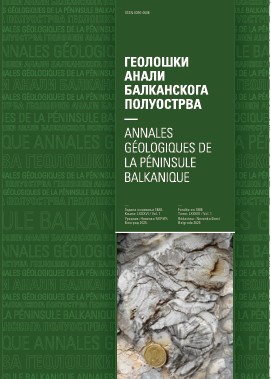A review of the Pb-Zn-Cu-Ag-Bi-W polymetallic ore from the Rudnikorefield, Central Serbia
Abstract
The Rudnik orefield is one of the well-known skarn-replacement and high-temperature hydrothermal Pb-Zn-Cu-Ag-Bi-W polymetallic sulfide deposits, and is a part of the Šumadija Metallogenic District, Serbia. It comprises ore bodies grouped into several major ore zones. The pseudostratified and platelike ore bodies have relatively high content of valuable metals. The average content varies in wide ranges: Pb (0.94–5.66 wt%), Zn (0.49–4.49 wt%), Cu(0.08–2.18 wt%), Ag(50–297 ppm), Bi(~100–150 ppm), and Cd(~100–150 ppm). Generally, a complex mineral association has been determined. Iron sulfides, arsenopyrite, chalcopyrite, sphalerite, galena and sulfosalts are abundant minerals in the ore. Carrier minerals of Bi and Ag are Bi-sulfosalts, such as galenobismutite, cosalite, Ag-bearing aschamalmite, vikingite, schirmerite and gustavite. Copper, Ag and Pb-Sb sulfosalts have been found only locally. Complex Ni-minerals (sulfides, arsenides and sulfoarsenidеs) with Fe, Co and Ag were formed under to the influence of present serpentine rocks and their yield of Ni, Co and Cr in the hydrothermal ore-bearing solutions. Significant scheelite mineralizations have been found in the Nova Jama, Gušavi Potok and Azna ore zones. The presence of Bi-sulfosalts and argentopentlandite suggests formation temperatures higher than 350, and lower than 445°C, respectively. Therefore, the mineralization was formed in the temperature range 350 to 400°C. The continuity of pyrite, pyrrhotite and siderite colloform bands in relic aggregates shows frequent changes of ƒS2 and ƒO2 in hydrothermal solutions. Isotopic composition of sulfur also confirms that the source of the ore-bearing fluids was magmatic. In addition, the enrichment of Bi and Ag indicates a magmatic origin. The appearance of Biminerals represents a significant genetic indicator for detection of increased Ag concentrations within the ore mineralizations. Typical gangue minerals are quartz, silicates, carbonates, oxides and different oxy-hydroxides. Special attention is given to the paragenetic relationships and the genetic significance of mineral associations as indicators of ore-forming conditions.
Copyright (c) 2018 Geološki anali Balkanskoga poluostrva

This work is licensed under a Creative Commons Attribution 4.0 International License.










